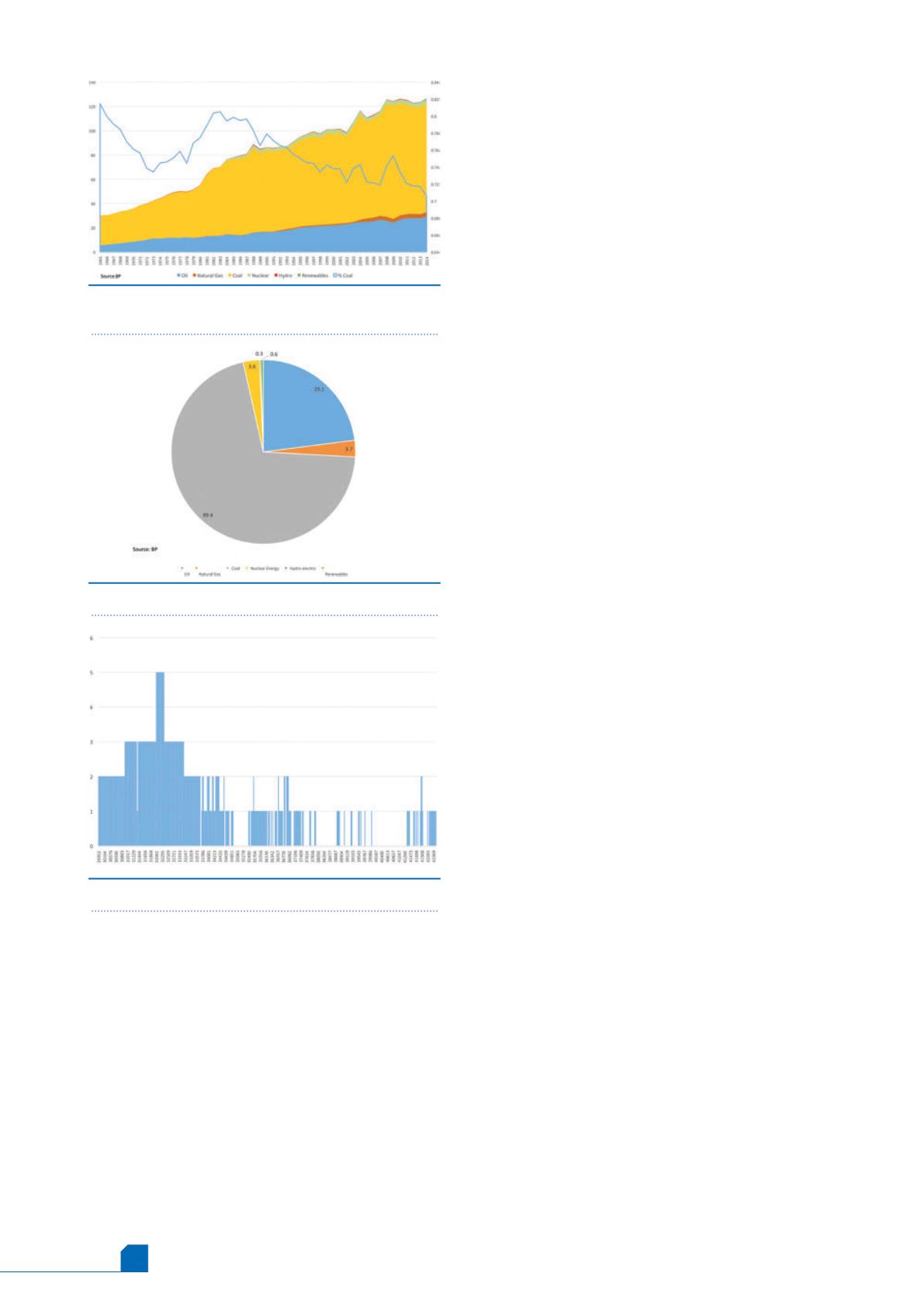
June
2016
HYDROCARBON
ENGINEERING
14
Figure 2 presents a look at the breakdown of fuels in the
primary energy mix, according to BP: coal supplied 70.6%, oil
supplied 23%, natural gas and nuclear energy supplied 2.9%
each, renewables supplied 0.5%, and hydroelectric power
supplied 0.2%.
Coal, oil, natural gas and shale gas
reserves
The Oil and Gas Journal, in its ‘Worldwide Report’, places
South Africa’s oil reserves at 15 million bbls. This amounts to a
mere 0.12% of Africa’s estimated oil reserves, and a vanishingly
small percentage of global oil reserves. The Oil and Gas Journal
estimates that current crude production is 3000 bpd.
South Africa’s natural gas reserves were listed as zero, though
the country does produce natural gas and is known for its
pioneering role as a gas to liquids (GTL) producer. Coal reserves,
in contrast, as estimated by BP, stand at 30.15 billion t, amounting
to 3.4% of global reserves, and having a reserves to production
ratio of 116 years.
South Africa’s government began searching for oil and gas in
the 1940s, under its Geological Survey of South Africa. The
government formed Soekor Pty Ltd in 1965 to oversee
exploration and development. Prospecting in the onshore areas
of the Karoo, Zululand and Algoa basins proved disappointing.
The government passed its Mining Rights Act in 1967, and it
granted offshore concessions to a variety of international
companies. The first offshore well was drilled in 1969.
Superior Oil discovered natural gas and condensate in the Ga-A1
well in the Pletmos Basin.
In the following years, South Africa’s Apartheid system
caused increasing internal resistance, strife and violence. The
international community ramped up its opposition to
Apartheid, beginning with bland diplomatic statements, but
gradually adding teeth by instituting arms embargoes and other
sanctions. South Africa largely became a pariah nation, and
international oil companies gradually left. Many investors
divested their holdings in South Africa. During those years,
Soekor explored alone, and with little success. The end of
Apartheid came in 1991, though most historians place the
effective date at 1994, when the first multi-racial elections were
held. The offshore areas were opened to international
companies in a new licensing round held in 1994.
Re-entering the international community stimulated
interest in South Africa’s oil and gas industry. The government
established a new state oil company, known as the Petroleum
Agency South Africa, in 1999. A new state oil company was
formed in 2001 via the merger of Soekor and Mossgas, known as
PetroSA. A newMineral and Petroleum Resources Development
Act was passed in 2002 and enacted in 2004.
The country’s oil and gas reserves are located primarily
offshore in the south portion of the country in the
Bredasdorp Basin and off the west coast of the country along
the border with Namibia. The offshore area near Namibia
includes the Orange Basin, believed to hold significant oil and
natural gas reserves, but these are not yet fully prospected or
commercial. This includes the Kudu gas field, which was
discovered long ago, in 1974, by a consortium including Soekor
and Chevron. Development and a pipeline to the coast are still
under consideration.
The advances made in hydraulic fracturing in the US
prompted countries around the world to assess shale oil and
shale gas potential. In 2013, the US Energy Information Agency
(EIA) published a report on shale resources, and South Africa
was noted as possessing the eighth largest technically
recoverable shale gas resource in the world. The EIA originally
estimated the reserves to be 485 trillion ft
3
, but later revised the
estimate down to 390 trillion ft
3
to reflect a downsizing of the
prospective areas. The shale gas resources are located in the
Karoo Basin in three formations known as Whitehill
(211 trillion ft
3
), Prince Albert (96 trillion ft
3
) and Collingham
(82 trillion ft
3
).
The public had many environmental concerns over the
potential development of the shale gas resource, largely over
the heavy demands that hydraulic fracturing places on water
resources. The South African government responded by placing
a moratorium on shale gas exploration until the impacts could
be considered. A government funded study later recommended
that the moratorium be lifted, and this was carried out in
September 2012. In October 2013, the government issued new
Figure 1.
South African primary energy use by type in
million toe.
Figure 2.
South African primary energy use.
Figure 3.
South African rig count.
Source:BakerHughes


